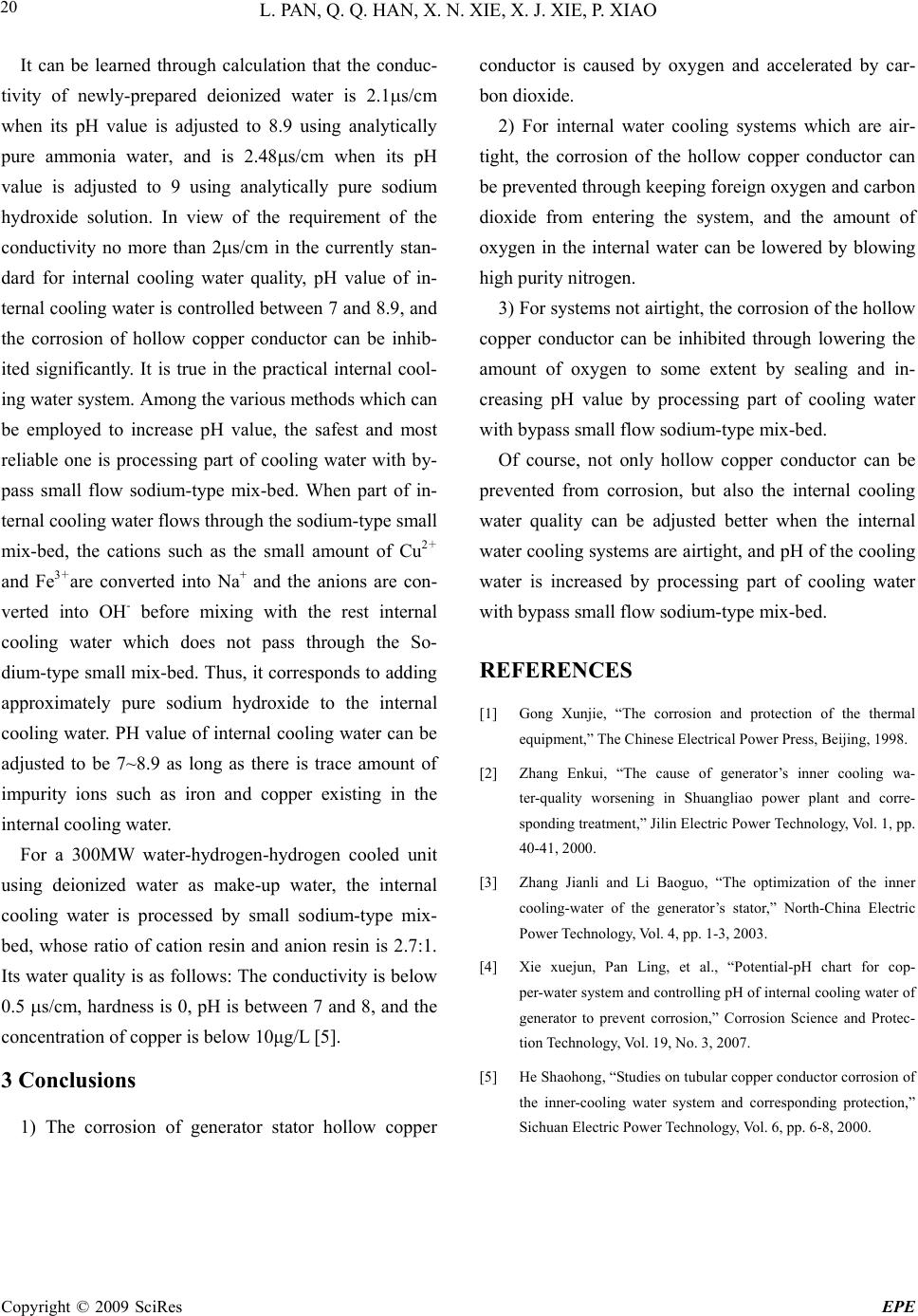
L. PAN, Q. Q. HAN, X. N. XIE, X. J. XIE, P. XIAO
Copyright © 2009 SciRes EPE
20
It can be learned through calculation that the conduc-
tivity of newly-prepared deionized water is 2.1s/cm
when its pH value is adjusted to 8.9 using analytically
pure ammonia water, and is 2.48s/cm when its pH
value is adjusted to 9 using analytically pure sodium
hydroxide solution. In view of the requirement of the
conductivity no more than 2s/cm in the currently stan-
dard for internal cooling water quality, pH value of in-
ternal cooling water is controlled between 7 and 8.9, and
the corrosion of hollow copper conductor can be inhib-
ited significantly. It is true in the practical internal cool-
ing water system. Among the various methods which can
be employed to increase pH value, the safest and most
reliable one is processing part of cooling water with by-
pass small flow sodium-type mix-bed. When part of in-
ternal cooling water flows through the sodium-type small
mix-bed, the cations such as the small amount of Cu2+
and Fe3+are converted into Na+ and the anions are con-
verted into OH- before mixing with the rest internal
cooling water which does not pass through the So-
dium-type small mix-bed. Thus, it corresponds to adding
approximately pure sodium hydroxide to the internal
cooling water. PH value of internal cooling water can be
adjusted to be 7~8.9 as long as there is trace amount of
impurity ions such as iron and copper existing in the
internal cooling water.
For a 300MW water-hydrogen-hydrogen cooled unit
using deionized water as make-up water, the internal
cooling water is processed by small sodium-type mix-
bed, whose ratio of cation resin and anion resin is 2.7:1.
Its water quality is as follows: The conductivity is below
0.5 s/cm, hardness is 0, pH is between 7 and 8, and the
concentration of copper is below 10μg/L [5].
3 Conclusions
1) The corrosion of generator stator hollow copper
conductor is caused by oxygen and accelerated by car-
bon dioxide.
2) For internal water cooling systems which are air-
tight, the corrosion of the hollow copper conductor can
be prevented through keeping foreign oxygen and carbon
dioxide from entering the system, and the amount of
oxygen in the internal water can be lowered by blowing
high purity nitrogen.
3) For systems not airtight, the corrosion of the hollow
copper conductor can be inhibited through lowering the
amount of oxygen to some extent by sealing and in-
creasing pH value by processing part of cooling water
with bypass small flow sodium-type mix-bed.
Of course, not only hollow copper conductor can be
prevented from corrosion, but also the internal cooling
water quality can be adjusted better when the internal
water cooling systems are airtight, and pH of the cooling
water is increased by processing part of cooling water
with bypass small flow sodium-type mix-bed.
REFERENCES
[1] Gong Xunjie, “The corrosion and protection of the thermal
equipment,” The Chinese Electrical Power Press, Beijing, 1998.
[2] Zhang Enkui, “The cause of generator’s inner cooling wa-
ter-quality worsening in Shuangliao power plant and corre-
sponding treatment,” Jilin Electric Power Technology, Vol. 1, pp.
40-41, 2000.
[3] Zhang Jianli and Li Baoguo, “The optimization of the inner
cooling-water of the generator’s stator,” North-China Electric
Power Technology, Vol. 4, pp. 1-3, 2003.
[4] Xie xuejun, Pan Ling, et al., “Potential-pH chart for cop-
per-water system and controlling pH of internal cooling water of
generator to prevent corrosion,” Corrosion Science and Protec-
tion Technology, Vol. 19, No. 3, 2007.
[5] He Shaohong, “Studies on tubular copper conductor corrosion of
the inner-cooling water system and corresponding protection,”
Sichuan Electric Power Technology, Vol. 6, pp. 6-8, 2000.